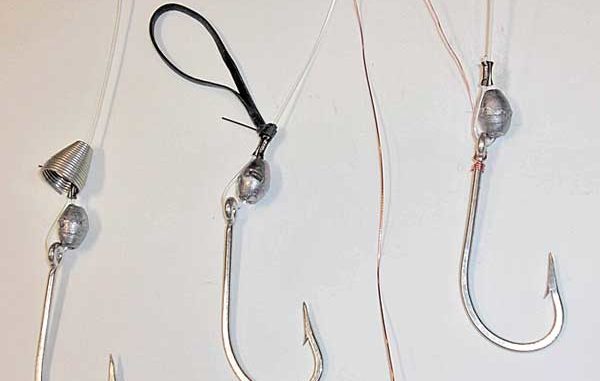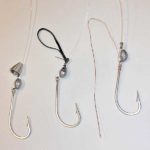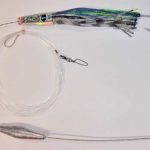
Getting rigged the right way for offshore trolling season takes some experience. While wahoo require specialized equipment like wire, weights and lures -— all of which can add up to put a “crimp” in your budget — one expert says that about $125 should cover all of your tackle needs for the entire dolphin season.
Jeremy Burnham has served as a mate on sportfishing boats in Panama, Florida, Alabama and New Jersey, but he can now be found at his rigging station inside Atlantic Game and Tackle in Mount Pleasant. Surrounded by buckets filled with trolling leads, crimps, hooks, mono and wire, Burnham can build you a custom rig or show you the “how-to” info for rigging on your own. Customers can use the rigging station, and Burnham will “grade” their work — all to increase hook-up ratios when offshore fishing.
For wahoo, Burnham recommends two options; an 18-inch piece of 900-pound wire cable rigged with a trolling lead (16, 24 or 32-ounces) — black to reduce reaction strikes from slashing wahoo — or a 20-foot piece of 200-pound monofilament shock leader with snap swivels at each end. Attach the mono to a 150-pound ball-bearing swivel (C-10 saltwater resistant) using a pair of crimpers, being careful to always crimp in the middle of the sleeve and giving the look of a bow-tie, which creates a soft edge where the mono rubs the crimping sleeve. Storing mono leaders is a cinch when you have a leader wheel handy — Burnham calls them a “Cuban Yo-Yo.”
Try the Black Bart San Sal Candy lure for wahoo because it has a “coned” head, which is less resistant than a chugger head. The size of the hook is very important. “The Black Bart is a proven lure that is designed to have a certain kind of swimming action, but if you go with too big a hook, it offsets the lure’s usefulness,” said Burnham, who said another tip is to slide the hook gap/width over the lure, and basically match their widths.
Since wahoo come fast from out of nowhere and hit baits hard, they are less concerned about seeing metal and veering off as are like say tuna and billfish. Burnham said, “You can’t go wrong with a Mustad 7691Z 8/0 stainless steel hook attached to 12 inches of a 275-pound steel leader.” When making your hookset with the wire leader, don’t be concerned with overcrimping, and use heat shrink-wrap when possible to create a “stiff point” between the eye of the hook and the wire leader — that keeps baits running straight.
Rigging for dolphin is a whole lot easier; all you need is a spool of 100-pound mono, some quarter-ounce lead weights and Mustad 7766D 7/0 or 9175 short- shank hooks. Cut the mono into strips six to seven feet long; that’s the starting point for three different dolphin rigs: the wire rig, the pin-and-spring rig and the pin-and-rubber band rig.
When rigging ballyhoo with a wire rig, put the hook eye at the back of their gill plate, wrap the wire through the hook eye, and then through the eyeball of the ballyhoo. Stick the wire through the bottom jaw and then up through the top lip before wrapping it around the bill.
“You want the pull of the line to be on the ballyhoo’s head and not on the hook eye, because that can create spinning, and there is no bait in the ocean that has a natural spinning motion,” Burnham said. “This rig is also good for sailfish because they are known for taking the bally like a dog bone, and if they feel the pin of the spring or rubber band rigs, they often just toss it away and don’t eat.”
The rubber band and spring rigs are easier to make on the fly, in the back of a sportfisher pitching in the ocean. Start the hook eye at the gill plate and use the rubberband to wrap the bill several times, or take the spring and twist it into position over the ballyhoo’s bill. The spring rig allows for different size ballyhoo — small, medium, selects or horse.
Want to dress up a bait? Burnham likes to keep it simple and recommends a 2-tone Sea Witch.
Burnham stresses that for best results, you want begin rigging your baits the night before fishing by thawing out your ballyhoo in saltwater. Take a 5-gallon bucket that is half-full of saltwater, add five pounds of ice and two cups of brine and, dunk your ballyhoo and let them sit for three hours, which serves to toughen their skin. Burnham adds that if a HOT dolphin bite is in effect, then just about any sort of ballyhoo thrown out will draw a strike.





Be the first to comment